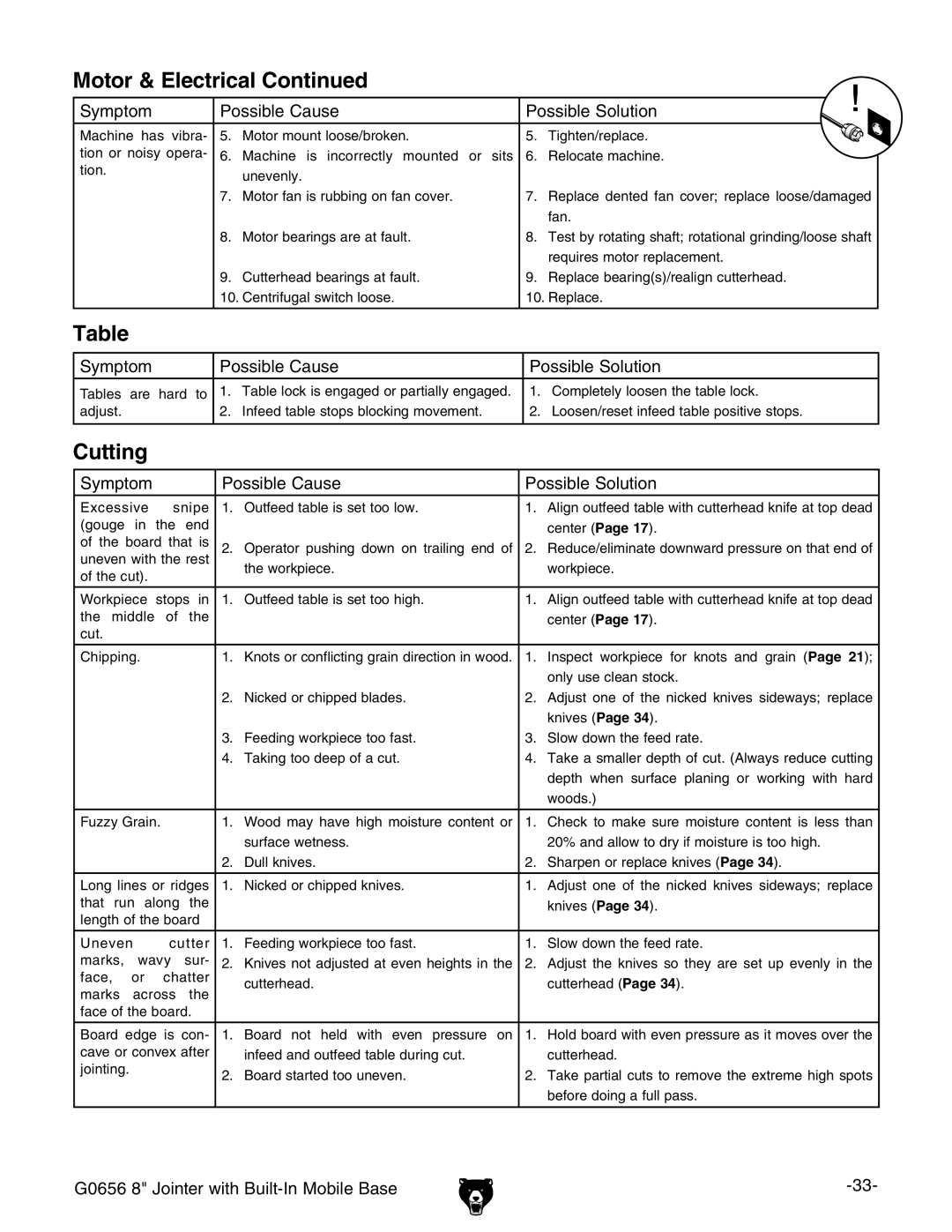
Motor & Electrical Continued
Symptom | Possible Cause | Possible Solution | ||
Machine has vibra- | 5. | Motor mount loose/broken. | 5. | Tighten/replace. |
tion or noisy opera- | 6. | Machine is incorrectly mounted or sits | 6. | Relocate machine. |
tion. |
| unevenly. |
|
|
|
|
|
| |
| 7. | Motor fan is rubbing on fan cover. | 7. | Replace dented fan cover; replace loose/damaged |
|
|
|
| fan. |
| 8. | Motor bearings are at fault. | 8. | Test by rotating shaft; rotational grinding/loose shaft |
|
|
|
| requires motor replacement. |
| 9. | Cutterhead bearings at fault. | 9. | Replace bearing(s)/realign cutterhead. |
| 10. Centrifugal switch loose. | 10. Replace. | ||
Table
Symptom | Possible Cause | Possible Solution | ||
|
|
|
|
|
Tables are hard to | 1. | Table lock is engaged or partially engaged. | 1. | Completely loosen the table lock. |
adjust. | 2. | Infeed table stops blocking movement. | 2. | Loosen/reset infeed table positive stops. |
|
|
|
|
|
Cutting
Symptom |
|
| Possible Cause | Possible Solution | |||
|
|
|
|
|
| ||
Excessive | snipe | 1. | Outfeed table is set too low. | 1. | Align outfeed table with cutterhead knife at top dead | ||
(gouge | in | the | end |
|
|
| center (Page 17). |
of the board that is | 2. | Operator pushing down on trailing end of | 2. | Reduce/eliminate downward pressure on that end of | |||
uneven with the rest |
| the workpiece. |
| workpiece. | |||
of the cut). |
|
|
|
| |||
|
|
|
|
|
| ||
|
|
|
|
|
| ||
Workpiece | stops in | 1. | Outfeed table is set too high. | 1. | Align outfeed table with cutterhead knife at top dead | ||
the middle | of | the |
|
|
| center (Page 17). | |
cut. |
|
|
|
|
|
|
|
Chipping. |
|
| 1. | Knots or conflicting grain direction in wood. | 1. | Inspect workpiece for knots and grain (Page 21); | |
|
|
|
|
|
|
| only use clean stock. |
|
|
|
| 2. | Nicked or chipped blades. | 2. | Adjust one of the nicked knives sideways; replace |
|
|
|
|
|
|
| knives (Page 34). |
|
|
|
| 3. | Feeding workpiece too fast. | 3. | Slow down the feed rate. |
|
|
|
| 4. | Taking too deep of a cut. | 4. | Take a smaller depth of cut. (Always reduce cutting |
|
|
|
|
|
|
| depth when surface planing or working with hard |
|
|
|
|
|
|
| woods.) |
|
|
|
|
|
| ||
Fuzzy Grain. |
| 1. | Wood may have high moisture content or | 1. | Check to make sure moisture content is less than | ||
|
|
|
|
| surface wetness. |
| 20% and allow to dry if moisture is too high. |
|
|
|
| 2. | Dull knives. | 2. | Sharpen or replace knives (Page 34). |
|
|
|
|
| |||
Long lines or ridges | 1. | Nicked or chipped knives. | 1. | Adjust one of the nicked knives sideways; replace | |||
that run along | the |
|
|
| knives (Page 34). | ||
length of the board |
|
|
|
| |||
Uneven | cutter | 1. | Feeding workpiece too fast. | 1. | Slow down the feed rate. | ||
marks, | wavy | sur- | 2. | Knives not adjusted at even heights in the | 2. | Adjust the knives so they are set up evenly in the | |
face, | or | chatter |
| cutterhead. |
| cutterhead (Page 34). | |
marks | across | the |
|
| |||
|
|
|
| ||||
face of the board. |
|
|
|
| |||
|
|
|
|
| |||
Board edge is con- | 1. | Board not held with even pressure on | 1. | Hold board with even pressure as it moves over the | |||
cave or convex after |
| infeed and outfeed table during cut. |
| cutterhead. | |||
jointing. |
|
|
| 2. | Board started too uneven. | 2. | Take partial cuts to remove the extreme high spots |
|
|
|
| ||||
|
|
|
|
|
|
| before doing a full pass. |
|
|
|
|
|
|
|
|
G0656 8" Jointer with |
